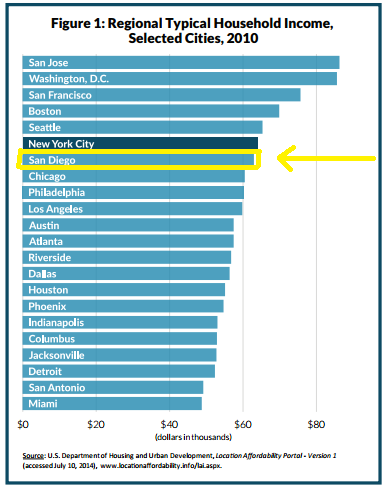By Andrew Keatts.
San Diego’s expensive housing is a big problem for the city. But it isn’t the city’s only affordability problem.
Residents are also plagued by the fact that, unlike many large cities, owning a car and all the expenses that come with it is almost a prerequisite for living here. And owning a car is expensive.
A new report from the Citizens Budget Commission of New York, a nonprofit research group, puts in context the effect that housing and transportation costs together can have on the overall cost of living in major U.S. cities.
CityLab looked at the report and concluded that affordable transportation can offset expensive housing to moderately suppress the cost of living in major cities.
But the report had a lot of bad news for San Diego, home to really expensive housing and really expensive transportation.
That’s really no surprise. The cost of housing and the necessity of car ownership here drove the city of San Diego in 2008 to adopt a new general plan that would accommodate population growth and try to push down housing costs by focusing new housing construction in dense neighborhoods, supported by a useful transit system.
That hasn’t really gone anywhere yet. The new general plan doesn’t actually make specific changes to development regulations – it leaves that to individual, community plans. And so far, new community plans haven’t been very consistent with that approach.
Some that have been proposed — along Morena Boulevard and in Grantville, for example — have run into local opposition, and in others, like Uptown, the city seems uninterested in pushing for more homes, despite its proximity to downtown and transit investments.
In the new report, which uses data from the federal Department of Housing and Urban Development and the Census Bureau, San Diego ranks third among cities in average rent, behind just San Jose and San Francisco, and ahead of other expensive places like Washington D.C., Boston, Los Angeles and New York.
It’s really expensive to live here, with a typical household spending more than $15,000 a year on rent.
But when you rank the expense of transportation, some of those other expensive cities do much better.
That’s not the case for San Diego. Here, your home is expensive, and so is your transportation.
That list on transportation costs matches up closely with this one, ranking cities by the share of the population that commutes via public transit, and the share of households that own cars.
Cities with effective public transportation — New York City, San Francisco, Philadelphia, Chicago, Boston — have lower annual transportation costs; those with the most expensive transportation — San Jose, Riverside, Jacksonville and San Diego — rely primarily on cars.
Turns out, owning a car (and paying for insurance, gas and ongoing maintenance), is really expensive.
San Diego ranks near the bottom in both. More than 90 percent of homes own a vehicle, and less than 5 percent of people use transit.
Together, this puts San Diego near the bottom of the CDC’s affordability index based on both housing and transportation costs.
The typical household in San Diego spends more than 40 percent of its annual income on housing and transportation. As expensive as housing is in Washington, D.C., San Francisco and New York City, the typical household in those areas all spend more like 30 percent of their money on homes and moving around.
The other side of the affordability ranking is the income for the typical household in each city. San Jose, for instance, comes out looking relatively affordable in spite of expensive housing and transportation because people there make a lot of money.
But that doesn’t explain the whole situation. The typical San Diego household does pretty well in income, compared with other cities. At just over $60,000 a year, it looks a lot like New York, yet people there have 10 percent more of that money to spend on things other than housing and transportation than San Diegans.
[divider] [/divider]
Originally posted at Voice of San Diego.









